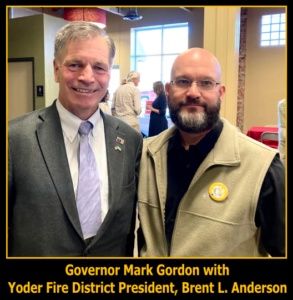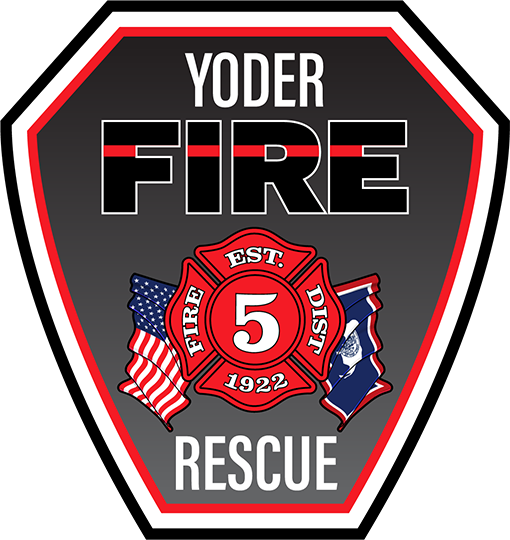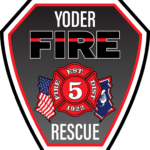 Yoder Fire District & Cowboy Iron
Yoder Fire District & Cowboy Iron
When Fire District President, Brent Anderson met with Governor Mark Gordon in the Fall of 2022, the Governor knew exactly who the Yoder Fire Department and Yoder Fire District was.
“I was impressed with his familiarity with the Yoder Fire Department; without prompting he started talking about our recent grants and new firetrucks. He knew the fine details too, not just general information.” Says President Anderson of his encounter with Governor Gordon.
Perhaps Anderson shouldn’t have been so surprised, as the Governor had actually held up the Yoder Fire Department as an example of excellence in a public speech, months before.
The Governor isn’t the only one to understand the innovative relationship between the Yoder Fire Department and the Yoder Fire District. Wyoming State Forestry has been instrumental in working with Yoder Fire to advise them on their continued growth, expansion and innovation. Yoder Fire not only impacts the Southeastern part of Wyoming, their impact reaches far and wide into states around the country through their active Federal Fire Response program where 2021 and 2022 were some of Yoder Fire’s most successful years.
One such success story is the partnership between Cowboy Iron and Yoder Fire. Robbie Edmunds founded Cowboy Iron, LLC in 2020 after working as a firefighter at Camp Guernsey for the previous 5 years.
In that role, his time was divided between Aircraft Rescue and Fire Fighting (ARFF), wildland fire mitigation and firefighting. He has been a certified wildland firefighter since 2004, shortly after enlisting in the Wyoming Army National Guard. Initially trained as a heavy equipment operator, Robbie saw an opportunity to combine this experience with his firefighting expertise.
He first set his sights on pursuing a federal Virtual Incident Procurement (VIPR) contract and purchased his first piece of equipment, a 1990 Komatsu D37E bulldozer. After witnessing the devastating impact of the Prairie Center fire in Goshen County, he realized the need for heavy equipment support within the county and surrounding areas was also present. “I had always pictured running equipment on federal fires, but after Prairie Center and seeing the local need, I started talking to Yoder Fire” Edmunds explained.
He initially contacted Justin Burkart, Yoder Volunteer Fire Chief, and together they approached the Yoder Fire District with a proposal to contract Cowboy Iron’s equipment and operators with the Fire District to provide support both locally as well as on state and federal fires.
Justin saw the benefit of a contract with the fire department and the district agreed. This way they are able to deploy and utilize Cowboy Iron’s equipment and personnel throughout the community as well as on a larger scale.
While knowing there was a significant need for this service, Robbie admits not being fully aware of just how great the demand would be once it started.
“After enrolling the dozer on the national board for the first time, we waited for several months for fire season to kick off. We deployed on August 15 that first year to Cameron Peak and didn’t come home until it snowed. In 2022, we had crews out beginning in March.”
In the past two years of operation, Cowboy Iron added a water tender, two Type 2 dozers, as well as support and transport vehicles. Additionally, four of Cowboy Iron’s employees have joined the Yoder Volunteer Fire Department, increasing the departments trained personnel.
Edmunds shared that some of the greatest experiences are seeing the impact of the equipment on people within local communities.
“There is so much appreciation from people. We heard some great things about a crew we had in Texas. They just jumped in with the local guys there and responded wherever they were needed. Closer to home, our tender worked the Sugarloaf Fire on Laramie Peak and had a great performance evaluation. We love seeing the difference our work makes to people who are experiencing probably the worst time of their lives.”
As Cowboy Iron has grown, they have been able to provide even more of that type of assistance close to home.
When the Lingle, WY canal breeched, Cowboy Iron along with Yoder Firefighters were some of the first responders assisting with clean up. Those on scene report it was Robbie Edmunds’ decisive leadership that directed the floodwater flow to the least damaging path, saving the town from devastation that could have been much worse. The whole team of earthmovers from various personal and professional resources came together seamlessly backing-up each other’s efforts. When asked about his role in the coordination of the team Robbie Edmunds humbly refused to take any sort of credit, instead he pointed to the amazing team effort of the community.
“Working alongside so many people from our area was just incredible. Being able to use the equipment and our guys’ expertise to help our neighbors is really gratifying. It means a lot to be able to provide a service that makes such a difference.” Edmunds said, evading credit.
The success of Yoder Fire is also apparent in the amount of Federal Firefighting Revenue they have generated in the past two years. All that success brings higher levels of accountability. In 2021 Yoder Fire District generated enough income/expense that WY State Statute requires an auditor review which was completed by Dana Cole and Company, LLP. In 2022 their income increased to the level requiring a full blown professional audit which was completed by Gardner, Loutzenhiser, & Ryan, P.C. These types of audits can take weeks to months to complete and can cost up to ten to fifteen thousand dollars.
“I personally don’t know if any other Goshen County fire districts that have been poked, prodded and audited more than the Yoder Fire District, but it’s nice to have all of this high level scrutiny and to pass with flying colors.” says Fire District President Anderson.
Yoder Fire has sent equipment and firefighters to Nebraska, Kansas, Colorado, New Mexico, California and Oregon just to name a few places. This income has led to purchasing newer and better equipment; increases in professional training of firefighters; better recruitment and improved services to the local residents in the District. Membership is up, participation is up and response times to local incidents are down to the lowest in the history of the 100 year old department.
Yoder Fire District and the Fire Department are on their way to surpassing past success. By years end, 2023, they will have one of the most up to date and well trained rural volunteer fire departments in the state. Here are a few highlights:
Equipment
Prior to expanding the federal fire program the average manufacture year of Yoder’s fire trucks was 1982. Those four trucks carried a total of 2050 gallons of water. The average manufacture age is now 2018 (6 trucks) with a total of 3900 gallons of water. In a little over 2 years they have decreased the overall age of their fleet by 36 years
Five years ago one could argue that sending resources to fight federal fire was a risk management issue, leaving the local area with less protection. Today even with two trucks on federal fire the local community is protected by four newer trucks plus a tanker. Every truck is a solid reliable truck.
In Spring of 2023 Yoder will be adding additional trucks including a tactical tender. This truck carries more water than a typical brush truck and can operate on just about any terrain. The current tanker is an example of a specialty truck – all it does is haul water. Yoder is strategically making its entire fleet multipurpose/multi use. Once all upgrades are complete every truck in in station will have a role in fighting grass fires, which equals 98% of all local calls.

Training
New shinny trucks and equipment is not enough. Yoder has also focused on growing its department to have personnel to run all of its equipment. In an era where recruitment of volunteer firefighters (nationally) is at an all-time low, Yoder’s recruitment is through the roof.
Yoder had 12 members complete the Firefighter 1 (FF1) training with 11 more members completing the FF2 training. They will have 16 members (64%) out of 25 fully certified in FF2 once complete. The goal is to have 100% of Yoder members FF2 certified by the beginning of 2024. It’s also notable that they logged over 1,600 hours of classroom training hours in 2022.
Federal Fire Program
Classroom training is necessary but hands-on experience is invaluable. In the last calendar year, Yoder firefighters have logged 16,165 hours on the fire line. The experience obtained on federal fire service is invaluable to rural departments that otherwise might take years to achieve that many hours of real life experience. You simply can’t replicate this with classroom training.
Wyoming volunteer firefighters make $28 to over $30 dollars per hour when serving in the federal firefighting service and this is often working 12 to 16 hour days for 14 day deployments. It’s not uncommon for a firefighter to make as much as thirty thousand dollars in just one summer of multiple deployments.
Yoder members made approximately $501,000 cumulatively last fire season. The Yoder District also gets paid for its equipment used on federal fire. Yoder’s equipment grossed $387,465 and Cowboy Iron grossed $724,449 for a grand total of $1,612,914 last fire season. This benefits local firefighters in experience and income but it also translates to benefits for the community at large.
Economic experts say money recirculates six to seven times in the community before it flattens out. Looking at financial impact, economists use a conservative number of 1.5 to figure out the economic impact of a dollar. Using this conservative number, Yoder Fire had a positive economic impact of $2.4 Million. Over the last two years the economic impact would equal over $4 Million to our community. If you used the six to seven times figures you get up to ten million (plus) dollars’ worth of impact.
Station Staffing
The federal fire funds have also brought in enough funds that Yoder is able to staff the station during peak hours. This would have been unheard of in a community this size just a decade ago. Volunteers are able to work as paid members to staff the station during the day, Monday – Friday. This statistically, has had the lowest availability of members to respond to calls. Volunteers have jobs just like anyone else which makes responding to fires most difficult on weekdays. Yoder has strategically reinvested its federal fire income and written grants to provide paid coverage at the fire station on weekdays. This has greatly reduced response times to dispatched fire calls and allowed firefighters to participate in public service such as helping with cross guard duties for the local Yoder school.
Calendar year 2022 to date, the response time from a dispatched page to driving out the door with a truck is 4 minutes 49 seconds. The previous average was 17 minutes and 19 seconds. When there is a fire or auto accident shaving even a few minutes is a huge improvement!
Success in member recruitment and federal fire services has led to dramatic improvements in the local Yoder Fire District. When Yoder Fire began its program, naysayers criticized the department over concerns of firefighters spending so much time away from the community on federal fire service. These concerns have proven to be shortsighted and uninformed. The improvement in equipment, recruitment, training and the shortened response times to local calls is one-hundred percent the result of the successful federal fire program.
Yoder Fire has strategically improved all areas of its operation and is now recognized as one of the most innovative and professional volunteer fire departments in the state of Wyoming.

